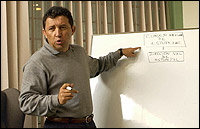
Image: Coca crop spraying photo: AP/WideWorld; other photos: Jeremy Bigwood
The big American suddenly stood up, leaned over the table and said to the Colombian in a low voice, “You’d better be careful not to talk to the press!”
Dr. David C. Sands, scientist and entrepreneur, was meeting with advisors to the Colombian Ministry of the Environment last March to push a new drug-war weapon marketed by his company: a special toxic fungus which would kill coca plants. The Colombian scientist who raised Sands’ hackles had pointed out that the fungus could also attack humans with weakened immune systems — a condition common among the often undernourished and generally unhealthy poor coca farmers and workers in the tropical rain forests of Colombia, where Sands wants to carry out a massive spraying program. “He didn’t care,” said the Colombian, who asked not to be named.
Sands is not the only party pushing this new biological weapon. The US Congress is demanding that Colombia apply the controversial fungus in order to receive $1.6 billion in emergency bailout funds for Colombia’s antidrug/counterinsurgency strategy called Plan Colombia. Last March, Rep. Benjamin Gilman, R-NY, tacked on an amendment to the pending aid bill requiring President Clinton to certify that the Colombian government “has agreed to and is implementing a strategy to eliminate Colombia’s total coca and opium poppy production” using, among other means “tested, environmentally safe mycoherbicides.” Myco = fungus; herbicide = plant killer.
Steve Peterson, an official with the State Department’s International Narcotics and Law Enforcement division, says they want to see mycoherbicides used because they would be “more cost effective and more environmentally friendly” than chemical herbicides.
The trouble is that abundant evidence indicates that the only mycoherbicide being considered for this purpose, Fusarium oxysporum, may in fact, in massive application, pose serious dangers to the environment and human health. Florida has put an indefinite hold on its plans to test the fungus for its own antidrug efforts after environmentalists and a state official warned that it could mutate, spread rapidly, and kill off other plants including food crops. And for over a decade, coca growers in Peru have accused the US of secretly applying the fungus there to attack coca plants — in the process also harming food crops and farm animals. Moreover, the fungus can, under certain circumstances, cause lethal infections in humans with weakened immune systems. None of this, however, has dimmed US government enthusiasm for the project — nor that of Sands’ corporation, which stands to profit if the fungus is adopted for widespread use.
Years of US-funded aerial spraying have so far failed to even slow Colombia’s thriving industries of coca plants, which produce the raw material for cocaine, and opium poppies, which are used to make heroin. The country’s cocaine and heroin production has more than doubled since 1995.
The New York Times reported in early May that US-funded spraying of the herbicide glyphosate (marketed as Roundup by Monsanto Company) may have exposed scores of Colombian villagers to harmful toxins and damaged nondrug crops. But the proposed Fusarium program, experts say, could unleash far worse consequences.
The UN Cover
The Congressional hardball mandating fungus use follows a less coercive approach to push Colombia into playing guinea pig for the first real on-the-ground testing of the toxic Fusarium oxysporum strain called EN-4. The first approach was through a United Nations Drug Control Program-proposed project to establish a research station to conduct field trials for eventual large-scale application of the fungus. Although the UN representative in Colombia, Klaus Nyholm, said the draft agreement is “not what the Colombians want,” it certainly reflects what the US State Department wants and has sold to Congress. The proposed agreement turns over results of at least 12 years of research by the US Department of Agriculture’s Agricultural Research Service (ARS) to refine the use of fungi against narcotic “weeds.” The agreement openly takes political cover under the UN umbrella. A May 1999 Action Request by Secretary of State Madeleine Albright pushes the UNDCP to get other countries to ante up “in order to avoid a perception that this is solely a (US government) initiative.”
Which, of course, it is. “It was an American interest,” said Nyholm. “It wasn’t my idea.”

|
While the concept of using herbicides against weeds and camouflaging foliage (such as Agent Orange in Vietnam) is not novel, using them against crops is. Ironically, the great majority of research on Fusarium focuses on combating it as a major food-crop killer. The soil-borne mold infects crops by secreting toxins into their roots, which then putrefy and dissolve the plant’s cells, often eventually killing them, or worse, poisoning humans or animals who feed on contaminated plants or plant products. The fungus can survive in soil for years.
The idea of using a fungal herbicide to kill drug plants began in the 1970s after a fungus, later identified as EN-4, began to kill off the coca at a soft drink research plantation in Kauai, Hawaii. In 1986, the ARS began a full-blown research project, classified for a time, to find a biological agent to kill coca. By 1991, the government had invested at least $14 million in it. Congress has now given the State Department $23 million originally slated for mycoherbicide development in the US, which State plans to pass on to the UN.
By getting the UN to take on the fungus project, the US not only gets political cover, but makes it harder to get information about the program. Unlike the US government, the UN has no Freedom of Information Act guaranteeing outsiders access to official documents.
The US Congress’ arm-twisting to make Colombia use the fungus even before it has been tested for environmental and human safety raises the fundamental issue of informed consent by the Colombian people. The program could easily be construed as having a nonpeaceful purpose, thus contravening the international Biological Weapons Convention and morphing it from “biocontrol” into “biowarfare.” While both the US and UN stridently object to the latter term, the secrecy surrounding the project — the lack of independent monitoring of the US fungus development, the lack of media exposure to the project, and the classified nature of the development program in its early years — leave serious questions unanswered.
Colombia targeted
When we visited Colombia in late March to research this article, the UN proposal had already landed in the Ministry of Environment, which must approve its use. At a meeting with ranking officials, however, it became clear that the Ministry had precious little to go on in making their decision. The vice minister of the environment and her aides gathered around the conference table were asking us, the journalists, to supply them with information. Neither the US government nor the UN agency pushing the plan had given the Ministry the detailed available documentation on the genesis and development of Fusarium oxysporum that they would need to help decide if it was safe to apply. Ministry staffers were reduced to trying to cull information from the Internet. What they had found there was evidence that Fusarium oxysporum could mutate to gobble other plants and could be dangerous to animal and human health.
Ministry advisers also told us that Peruvian organizations had not responded to queries on the fungus epidemic that had affected coca fields there. Since 1991, Peruvian coca growers have charged that they have seen helicopters fly over their coca fields emitting a brown or white cloud which caused their coca and food crops to die and sickened their farm animals. Many of the farmers believe these helicopters are part of an American antidrug campaign, a charge the US denies. Research in 1993 by a US-funded Peruvian scientist showed that many of the food crops were infected by the same fungus species that had killed the coca.
There are many troubling aspects to the UN proposal. It maintains that EN-4 already exists in Colombia, which is convenient since introducing a foreign pathogen to the country would present a problem under international law; UN representative Nyholm, however, says there is no EN-4 in Colombia. The proposal admits that fungus development, large-scale production, storage, and application techniques for Fusarium already exist; now, it says, all that’s needed are “large-scale” field trials to compare different formulations and application rates, and assess the environmental impact. Yet it doesn’t specify how they would measure the safety of these trials. Nowhere in the draft is any noninvolved stakeholder monitor established to oversee research and development in Colombia. And while the vice minister says they have yet to approve the fungus, the draft proposal and State Department “Action Request” both make clear that someone in the Colombian government has already demonstrated a willingness to forge ahead, with or without the Environment Ministry’s approval.
This is no small matter in Colombia, home to the world’s second most diverse biosystem — one that is uniquely vulnerable to the potential threat posed by the massive spraying of a toxic, mutative fungus in vast swaths of jungle.
Will it really attack only coca?
Department of Agriculture research documents on the fungus explicitly avow that it is environmentally safe and would attack only coca. But Colombian researchers and scientists are far from convinced — especially given Fusarium‘s notorious tendency to mutate.
Colombia is no stranger to Fusarium, a genus that includes several strains besides EN-4. “There’s a group of scientists who’ve been working [to combat] Fusarium here for a long time,” said Vice Minister Martinez. In fact a major epidemic of one Fusarium strain hit the flower growers in the plains of Bogotá a few years ago, and as a result, growers could no longer plant in the contaminated earth — they were forced to switch to soilless hydroponics systems.
US scientists also maintain that the EN-4 strain will only attack plants within the genus Erythroxylum, of which coca is one. But there are over 200 other plant species within that genus, many of which are found in Colombia, which EN-4 could then kill besides its intended target. Plants of the Erythroxylum genus are also used by indigenous populations for medicinal and religious-cultural practices would also be at risk.

|
Moreover, a 1995 International Institute of Biological Control report on the ARS fungus program admitted that non-Erythroxylum North American plants under stress could be infected by EN-4. Surprisingly, this seems to be the only research testing EN-4’s ability to attack other plants. Luis Parra, an herbicide expert recommended to us by the American Embassy who oversees the glyphosate spraying of coca and opium in Colombia, says he has “a lot of doubts” about Fusarium. “I don’t believe in the specificity of these organisms,” he said. “It is very different to apply an herbicide (such as glyphosate) that has a known and predictable and undeniable risk, than to apply a microbe (such as a mycoherbicide) where the risks are still unknown.”
Risks extend to human health
While the US continues to murmur its “environmentally safe” mantra, Eduardo Posada, head of the Colombian Center for International Physics, believes that Fusarium can be devastating to people with lowered resistance due to immunological diseases or malnutrition — common conditions among the farmers who often live near the coca fields that would be sprayed with the fungus.
“The mortality rate for people infected by Fusarium is 76 percent,” wrote Posada in a letter to the minister of environment. He lists the scientific literature indicating that Fusarium toxins are “highly toxic” to animals and humans, and that the use of ants to spread the fungus (research actually done by ARS scientists), could cause the ecosystem to be affected much faster than imagined.
None of that, however, appears to trouble David Sands.
Pecuniary interests? Presenting Dr. Sands
Vice Minister Claudia Martinez was ordered by the Colombian ambassador in Washington to receive Dr. David C. Sands, a professor at Montana State University in Bozeman and the vice president of Ag/Bio Con (agricultural biological control), a company that markets the fungus. He is listed as a major researcher of the fungus in the UN proposal, and it was he who first isolated EN-4 for ARS in Hawaii. Yet now he seems to be more appropriately classified as a free-lance businessman, hawking his company’s version of a fully developed fungus field-ready for “precision delivery from high altitude” application by large C-130 cargo planes — as a picture in his literature shows.
Sands has no shortage of influential contacts. Ag/Bio Con has retained a prominent DC consulting firm to lobby on bills related to mycoherbicide development. The company’s officials include a retired Air Force General with a background in research; Sands has received a Navy research award and has traveled with ranking US government personnel to a similar fungus project in Kazakhstan and Russia. Through his Congressional connections, he arranged a face-to-face meeting with President Andrés Pastrana in Washington last January.
Sands did not return repeated phone calls for comment on this article.
Sands received nationwide attention for Ag/Bio Con in spring and summer of last year, when he — along with Colonel Jim McDonough, a former top aide to US drug czar General McCaffrey who had taken a new job as Florida’s top drug official — tried a similar sales job to use another strain of Fusarium to control Florida’s burgeoning marijuana industry. David Struhs, the head of Florida’s Department of Environmental Protection, reacted with a strongly cautionary letter saying: “Fusarium species are capable of evolving rapidly … Mutagenicity is by far the most disturbing factor in attempting to use a Fusarium species as a bioherbicide. It is difficult, if not impossible, to control the spread of Fusarium species. The mutated fungi can cause disease in a large number of crops, including tomatoes, peppers, flowers, corn and vines, and are normally considered a threat to farmers as a pest, rather than as a pesticide. Fusarium species are more active in warm soils and can stay resident in the soil for years. Their longevity and enhanced activity under Florida conditions are of concern, as this could lead to an increased risk of mutagenicity.”
Having been rebuffed by the state of Florida — failing even to convince the state authorities to initiate a simple experiment in a quarantined test site — Sands apparently set his sights on Colombia.
Two scientists who attended Sands’ Colombia presentation said he first presented himself only as a scientist, not mentioning Ag/Bio Con. When asked about aerial application, they said he got flustered seeing they already had his sales literature. His goal seemed to be to find four hectares anywhere to use for a field trial.
The US full-court press
That goal may be within reach. With the State Department pushing the UN and the US Congress threatening fund cutoffs, the pressure is on and the stakes high.
Two biologists who made a case on Colombian TV against the UN proposal say colleagues have told them to cool the rhetoric. One, who asked that his name not be used, says he received telephone threats after his statements and is now watching his mouth. “Various times I’ve answered the phone and they’ve said … they know where they can find me, where I teach, at what times I go out and I think that the country has enough heroes,” he told us.
In response to the pressures, the Ministry of Environment has come up with a preliminary counterproposal, calling for back-to-basic research on “native micro-organisms with biocontrol potential” in the coca zones. The proposal does not rule out the unpredictable and dangerous Fusarium, as some scientists have demanded. But it does call for a long, meticulous study emphasizing safety over the expediency urged by the State Department and members of Congress.
After all, why should the people of Colombia expose themselves to a risk the people of Florida refused to run? “If we’re going to ask, for example, the Colombians to do something,” said Andy Bernard, spokesman for the Florida Office of Drug Control, “we ought to have the guts to do it here as well.”
















